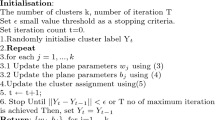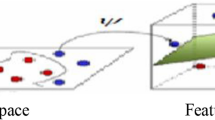Abstract
MRI images are complex, and the data distribution of tissues in MRI are non-spherical and overlapping in nature. Plane-based clustering methods are more efficient in comparison to centroid based clustering for non-spherical data, and soft clustering methods can efficiently handle the overlapping nature by representing clusters in terms of fuzzy sets. In this paper, we propose fuzzy entropy k-plane clustering (FEkPC), which incorporates the fuzzy partition entropy term with a fuzzy entropy parameter in the optimization problem of the conventional kPC method. The fuzzy entropy parameter controls the degree of fuzziness, the same as the fuzzifier parameter in the fuzzy clustering method. The fuzzy entropy terms try to minimize averaged non-membership degrees in the cluster. The performance of the proposed method has been evaluated over three publicly available MRI datasets: one simulated and two real human brain MRI datasets. The experimental results show that the proposed FEkPC method outperforms other state-of-the-art methods in terms of ASA and Dice Score.
Access this chapter
Tax calculation will be finalised at checkout
Purchases are for personal use only
Similar content being viewed by others
References
Bai, X., Zhang, Y., Liu, H., Chen, Z.: Similarity measure-based possibilistic FCM with label information for brain MRI segmentation. IEEE Trans. Cybern. 49(7), 2618–2630 (2018)
Balafar, M.: Fuzzy C-mean based brain MRI segmentation algorithms. Artif. Intell. Rev. 41(3), 441–449 (2014)
Bezdek, J.C., Ehrlich, R., Full, W.: FCM: the fuzzy C-means clustering algorithm. Comput. Geosci. 10(2–3), 191–203 (1984)
Bora, D.J., Gupta, D., Kumar, A.: A comparative study between fuzzy clustering algorithm and hard clustering algorithm. arXiv preprint arXiv:1404.6059 (2014)
Bouchon-Meunier, B., Detyniecki, M., Lesot, M.J., Marsala, C., Rifqi, M.: Real-world fuzzy logic applications in data mining and information retrieval. In: Wang, P.P., Ruan, D., Kerre, E.E. (eds.) Fuzzy Logic. STUDFUZZ, vol. 215, pp. 219–247. Springer, Heidelberg (2007). https://doi.org/10.1007/978-3-540-71258-9_11
Bradley, P.S., Mangasarian, O.L.: K-plane clustering. J. Glob. Optim. 16(1), 23–32 (2000)
Cocosco, C.A., Kollokian, V., Kwan, R.K.S., Pike, G.B., Evans, A.C.: BrainWeb: online interface to a 3D MRI simulated brain database. In: NeuroImage. Citeseer (1997)
Dhanachandra, N., Chanu, Y.J.: A survey on image segmentation methods using clustering techniques. Eur. J. Eng. Technol. Res. 2(1), 15–20 (2017)
Gan, G., Wu, J., Yang, Z.: A fuzzy subspace algorithm for clustering high dimensional data. In: Li, X., Zaïane, O.R., Li, Z. (eds.) ADMA 2006. LNCS (LNAI), vol. 4093, pp. 271–278. Springer, Heidelberg (2006). https://doi.org/10.1007/11811305_30
Ghosal, A., Nandy, A., Das, A.K., Goswami, S., Panday, M.: A short review on different clustering techniques and their applications. Emerg. Technol. Model. Graph., 69–83 (2020)
Liu, J., Pham, T.D., Yan, H., Liang, Z.: Fuzzy mixed-prototype clustering algorithm for microarray data analysis. Neurocomputing 276, 42–54 (2018)
Nie, F., Wang, C.L., Li, X.: K-multiple-means: a multiple-means clustering method with specified k clusters. In: Proceedings of the 25th ACM SIGKDD International Conference on Knowledge Discovery & Data Mining, pp. 959–967 (2019)
Zhu, L., Wang, S,, Pan, Y., Han, B.: Improved fuzzy partitions for K-plane clustering algorithm and its robustness research. J. Electron. Inf. Technol. 30(8), 1923–1927 (2008)
Smith, S.M.: BET: brain extraction tool (2000)
Tran, D., Wagner, M.: Fuzzy entropy clustering. In: Ninth IEEE International Conference on Fuzzy Systems. FUZZ-IEEE 2000 (Cat. No. 00CH37063), vol. 1, pp. 152–157. IEEE (2000)
Zadeh, L.A.: Fuzzy sets. In: Zadeh, L.A. (ed.) Fuzzy Sets, Fuzzy Logic, and Fuzzy Systems: Selected Papers, pp. 394–432. World Scientific (1996)
Author information
Authors and Affiliations
Corresponding author
Editor information
Editors and Affiliations
Rights and permissions
Copyright information
© 2022 The Author(s), under exclusive license to Springer Nature Switzerland AG
About this paper
Cite this paper
Kumar, P., Kumar, D., Agrawal, R.K. (2022). Fuzzy Entropy k-Plane Clustering Method and Its Application to Medical Image Segmentation. In: Raman, B., Murala, S., Chowdhury, A., Dhall, A., Goyal, P. (eds) Computer Vision and Image Processing. CVIP 2021. Communications in Computer and Information Science, vol 1568. Springer, Cham. https://doi.org/10.1007/978-3-031-11349-9_31
Download citation
DOI: https://doi.org/10.1007/978-3-031-11349-9_31
Published:
Publisher Name: Springer, Cham
Print ISBN: 978-3-031-11348-2
Online ISBN: 978-3-031-11349-9
eBook Packages: Computer ScienceComputer Science (R0)




